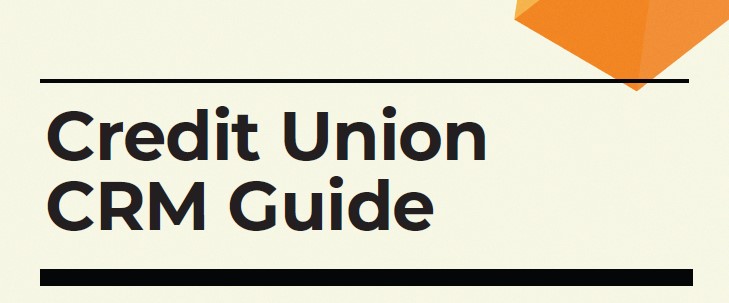The goal of Customer Relationship Management (CRM) is to improve and manage interactions with members. CRMs help credit unions manage member information, track interactions, and facilitate communication.
This includes capturing member details, tracking leads, recording transactions, and segmenting members based on their preferences or behaviors. CRMs help credit unions organize and manage their member data in a centralized system, making it easier to deliver personalized service and targeted marketing campaigns.
In many ways, you can think of a CRM as a basic “single source of truth” for any given member. There may be better tools to accomplish this—or better tools to encourage credit unions to take the next step, whether marketing, sales, or communication—but CRMs are classic sales and marketing platforms for a reason.
If you’re looking to improve your credit union’s sales and marketing capabilities, a CRM is potentially a great tool. It can help you build and maintain strong, lasting relationships with members while also helping you grow.
Download this guide here:
CRM Trends and Statistics
1. A complete view of each member.
In a world of digital-first banking, the relationship between credit union and member has changed. Now, “knowing” your member doesn’t mean greeting them by name when they enter the branch—it means having a complete view of the member’s data.
CRMs provide a better understanding of each member. They’ll show member history and engagement. They’ll also show what products each member has, which they’re eligible for, and what they might need next. Finally, they’ll show you how to help the members along in their financial journeys.
These technologies are critical in understanding members, individually.
2. Increased marketing and sales support.
Most members use other financial services. They might use Venmo for P2P payments, Robinhood for investments, and American Express for a credit card.
You may have competing products, but your members may not know. If you want to compete against other financial institutions and fintechs, you need to give your marketing and sales a shot in the arm. CRMs improve sales by helping you identify and act on opportunities. At their core, CRMs will help you understand each member’s financial system and product mix, allowing you to see what else they may need. Ultimately, if used well, they’ll boost your revenue and bottom line.
3. Tying together a fractured product landscape.
CRMs help credit unions bring all your products and services together under one roof. If you want to help a member with a vehicle refinance—and then help them with GAP insurance—a CRM will ensure that the member will be aware of everything you can offer them.
And if that member starts on your website, then moves to your app, and maybe explores other products along the way, then a CXM will ensure that the whole experience is seamless and branded. (As credit unions rely more and more on fintechs and CUSOs to provide products and services, CXMs become increasingly attractive.)
Download other credit union vendor guides here!
Evaluation Strategies
There are a lot of CRMs out there, and it might be hard to find the right one for your credit union. If you’re deciding between a few options, these questions and considerations may help you narrow down the field to find the best fit.
Security and Compliance
Does the CRM meet or exceed your security and compliance standards? Is it well positioned to meet emerging ones as well?
Industry-Specific Features
Does the product come with functions tailored to community financial institutions? More importantly, does it come with functions tailored to credit unions?
Customized Workflows
Does the solution come with prebuilt and/or customizable workflows? Is it suited to work with loan origination and processing, account opening and closing, and financial product management?
Integrations
Will the solution integrate with your tech stack? Will it play nice with your core, your loan origination platforms, etc.? Is the CRM already connected to other products in your ecosystem, or will it require manual integrations?
Reporting and Analytics
Some CRMs are incredibly basic, while others have a suite of customized report, analytics, and visualization tools that assist with marketing, member engagement, and more. What do you need? And what will the CRM provide?
Support and Training
Does the provider offer training? How much? Can you be sure that your credit union will get the most out of the solution or will you be left on your own?
Ease of Use
One of the main reasons why CRMs don’t work or get abandoned is because teams don’t use them. Is the CRM easy to use?
Download this and other Credit Union Guides here.
Fintech Categorizations
Most fintechs fit into 3 categories:
- Those that want to steal your lunch. These are generally direct competitors or short-time partners that reduce your share of the member’s wallet.
- Those that want to sell you lunch. These fintechs will provide you and your members a service, and they’ll charge you the same whether it’s successful or not.
- Those that want to share lunch with you. Some fintech financial success is contingent on their product success, so they’re uniquely incentivized to ensure good outcomes for partnered credit unions.
Generally, CU 2.0 recommends looking into fintechs that want to share lunch (and avoiding those that want to steal your lunch), but there are good partners across the spectrum.
Credit union CRMs don’t fall into the typical Steal, Sell, and Share categories. Accordingly, we’ve omitted this section of the guide in favor of including more information about the vendors’ focus on credit unions.
CRM and CXM Fintech Ratings
Rating Methodology
CU 2.0’s rating methodology attempts to score fintechs based on the 4 most important factors for credit unions:
- Income statement: (1) Non-interest income and/or deposits, (2) interest income, (3) both
- Balance sheet: (1) Deposits, (2) loans, (3) both
- Member impact: By members affected: (1) 1–33%, (2) 33 – 66%, (3) 66–100% and/or memberization
- Employee impact: (1) Improves workflows, (2) automates some, (3) automates a lot
We score each category above on a scale of 1 to 3 according to the scale above, with scores of 0 indicating that the solution has no known impact. Additionally, in some guides, providers will have very similar scores.
Our ratings don’t necessarily correlate to quality, nor do they suggest which solution is best for you.
Fintechs with higher scores aren’t automatically better, or a better fit, for your credit union and members. Additionally, please note that these ratings are estimations based on our understanding of the product or service.
The following development first are listed alphabetically. Trusted solutions are highlighted with an asterisk—these are fintechs that CU 2.0 has vetted personally.
| Organization | Description | Income | Balance | Member | Employee |
| Creatio | Creatio offers a no-code CRM for credit unions and a few other select industries. | 2 | 1 | 3 | 2 |
| CRMNEXT | CRMNEXT incorporates AI into their FI-specific CRM solution. | 2 | 1 | 3 | 2 |
| Datava* Learn more | Datava offers a CRM with a wide array of inbuilt CU- and banking-specific features. Datava’s CRM can be used as a standalone product or as part of its full ecosystem of credit union solutions. | 2 | 1 | 3 | 2 |
| Doxim | Doxim provides both a CRM and communications management platform for credit unions. | 2 | 1 | 3 | 2 |
| HubSpot | HubSpot is one of the leading marketing automation platforms and CRMs for all industries. If you’re interested in CU-specific support, guidance, and exclusive discounts for HubSpot, consider Nook below. | 2 | 1 | 3 | 2 |
| LeadSquared | LeadSquared built credit union-specific capabilities into its multi-industry CRM. | 2 | 1 | 3 | 2 |
| Monday | Monday is one of the largest CRMs with robust integrations. | 2 | 1 | 3 | 2 |
| Nook* Learn more | Nook helps credit unions build non-banking relationships with their members by catering to their interests without bombarding them with product offers, allowing them to “sell without selling.” As a CUSO and Hubspot partner, Nook makes an excellent guide and partner to help CUs get the most from their CRM. | 2 | 1 | 3 | 2 |
| Onovative | Onovative offers a CRM along with their other customer experience products. | 2 | 1 | 3 | 2 |
| Quest Analytics | Quest Analytics provides a CRM alongside other marketing and sales modules. | 2 | 1 | 3 | 2 |
| Sage | Sage offers a CRM along with a variety of other business software. | 2 | 1 | 3 | 2 |
| Salesforce | Salesforce is one of the largest CRMs in the world and specializes in enterprise-level organizations. | 2 | 1 | 3 | 2 |
| SugarCRM | SugarCRM can be used by all levels of CU staff, including tellers. | 2 | 1 | 3 | 2 |
| Zoho | Zoho is one of the largest, simplest, and most integration-friendly CRMs for any industry. | 2 | 1 | 3 | 2 |
Please note that these ratings may be updated as we include more data and more complex variables. The ratings are estimates—your credit union could see a different level of impact than listed in this guide.
Did we miss a fintech? Please let us know at info@cu-2.com
Recommendations
Choosing the right fintech partners is never as easy of a decision as we’d like. There are no one-size-fits-all solutions. However, we’ve worked closely with Datava for several years to ensure that their CRM is not just CU-ready, but CU-optimized. Their CRM also fits well in their range of other CU-specific products.
Consequently, we recommend including Datava in your shortlist, especially if you have interest in other Datava products or services.
Similarly, Nook is a CUSO that partners with our favorite generic CRM, Hubspot (which does have a CU-specific product), to ensure that credit unions get optimal benefit and ROI, as well as guidance, optimization, and deals.
Accordingly, we also recommend including Nook in your shortlist, especially if you’re interested in using Hubspot or prefer a standalone CRM option.
At CU 2.0, we discover, research, and work with fintechs all day, every day. Often, we’ll have unique insights about a company’s product, team, or operations that won’t show up on a sales sheet.
So, although we can’t give blanket recommendations through a downloadable guide, we can do something even better. Book a 30-minute consultation with us at no cost here:
Each quarter, we’ll review and discuss fintechs you’re looking at. We’ll also introduce other fintechs that may be of interest!
Download this guide here:




